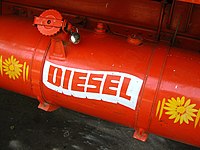
Photo from wikipedia
ABSTRACT A common lubricating oil sump is used in most modern internal combustion engines for cooling, wear protection, and friction reduction. This requires compromises during base oil and additive selection… Click to show full abstract
ABSTRACT A common lubricating oil sump is used in most modern internal combustion engines for cooling, wear protection, and friction reduction. This requires compromises during base oil and additive selection as a result of differing needs for lubricant performance in engine subsystems. The use of a dual lubricating loop, providing separate oil sumps for the power cylinder and valve train subsystems, was investigated experimentally to determine the effect of system segregation on oil degradation. A small diesel engine was modified, installed in a commercial generator unit, and operated for one oil drain cycle. Oil sampling was tailored to assess base and acid numbers, oxidation, soot concentration, water content, and viscosity changes. The experiment complemented an earlier study that investigated the fuel economy benefits of such a lubricating configuration. These include longer drain intervals for the cylinder head and power cylinder subsystems, improved wear performance for the valve train, and opportunities for alternative material selection during engine design. The experiment demonstrated protection of the valve train subsystem from soot contaminants in the power cylinder. Lower total acid number and oxidation tendency was also observed in the valve train.
Journal Title: Tribology Transactions
Year Published: 2018
Link to full text (if available)
Share on Social Media: Sign Up to like & get
recommendations!